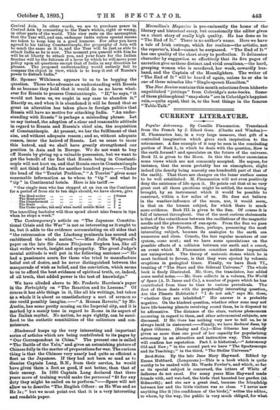CURRENT LITERATURE.
Popular Astronomy. By Camille Flammarion. Translated from the French by J. Ellard Gore. (Chatto and Windus.)— M. Flammarion has, in a very large measure, that gift of a. controlled imagination which gives such inspiration to the astronomer. A fine example of it may be seen in the concluding portion of Book I., in which he deals with the question, How is the earth formed ? and speculates on the future of the universe._ Book II. is given to the Moon. In this the author enunciates some views which are not commonly accepted. He argues, for instance, that the moon probably has an atmosphere, slight indeed (its density being scarcely onshundredth part of that of the earth). That there are changes on the lunar surface seems to be well established. M. Flammarion will not even positively deny the existence of life upon it. He points out that at no very great cost all these questions might be settled, the moon being brought, by an instrument which it would be possible to. construct, within a few miles of us. He does not believe in the weather-influence of the moon, nor, it would seem„ in that on the human subject, for which there is much, more evidence. Book III. is given to the Sun. Of course it is full of interest throughout. One of the most curious statements is that of the coincidence between the oscillations of the magnetic. needle and the phenomena of sun-spots. From the Sun we pass naturally to the Planets, Mars, perhaps, presenting the most interesting subject, because its analogies to the earth are numerous and close. Comets, the less regular members of our system, come next ; and we have some speculations on the possible effects of a collision between our earth and a comet,. an event which M. Flammarion considers neither impossible nor unimportant. The theory of meteoric stones which he is most inclined to favour, is that they were ejected by volcanic- eruptions in geological times. Finally, we have Book VT.,. treating of "The Stars and the Sidereal Universe." The whole book is finely illustrated. Mr. Gore, the translator, has added some useful notes.—Mr. Gore collects in a volume, The World of Space (A. D. Innes and Co.), a number of papers which he has, contributed from time to time to various periodicals. The first of these deals with the perpetually interesting question,. Are the Planets Habitable ? "I do not ask," says Mr. Gore,. "whether they are inhabited." His answer is a probable negative. On the kindred question, whether other sans may not have life-bearing planets revolving round them, he is disposed to. be affirmative. The distance of the stars, various phenomena' occurring in regard to them, and other astronomical subjects, are discussed. If Mr. Gore has nothing very new to tell us, he is* always lucid in statement.—Finally, we have Radiant Suns, by Agnes Giberne. (Seeley and Co.)—Miss Giberne has already given us more than one proof of her capacity for popularising astronomy in an attractive and instructive way. This volume will confirm her reputation. Part I. is historical,—" Astronomy Old and New ; " in the second part we have "The Spectroscope. and its Teaching;" in the third, "The Stellar Universe."






































 Previous page
Previous page